Don't wanna be here? Send us removal request.
Text
Memes in Digital Culture Book Report
I looked more into memes and its relation to the internet and its effect on culture by reading the “Memes in Digital Culture” by Limor Shifman. In this book, Limor Shifman examines Internet memes and what they might reveal about contemporary culture.
According to Shifman (2013, p. 18) “What Internet users seemed to have grasped-and Richard Dawkins couldn't have imagined back in 1976- is that the memes the best concept to en-capsulate some of the most fundamental aspects of the Internet in general, and of the so-called participatory or Web 2.0 culture in particular. Three main attributes ascribed to memes are particularly relevant to the analysis of contemporary digital culture: (1) a gradual propagation from individuals to society, (2) reproduction via copying and imitation, and
(3) diffusion through competition and selection.” is that the recent generations of the internet era has figured it out to summarise historical periods of parts of the internet into this immortalised imagery, by having these 3 criteria, from community to worldwide, flexibility of the meme to adapt and the wave of internet jokes being created daily, “battling” the other “competitors” for the algorithm to show above the sea of inside jokes.
This was proved by Shifman (2013, p. 55) “ he three key attributes of virality, ac- cording to these authors, are (1) a person-to-person mode of diffusion; (2) great speed, which is enhanced by social media platforms; and (3) broad reach, which is achieved by bridging multiple networks.”
Memes can also be used as device for political campaigned as supported by Shifman (2013, pp. 122-123) inciting street protestors for injustice and flawed policies, first started by the outside involvement of the Time magazine referring mass protests the title of “Person of the year” as the creation of memes are accessible and simplified therefore, huge events made up throughout the year can be turned into a single commentary meme.
Bibliography
Shifman, L (2013) Memes in Digital Culture. [accessed at 4 may 2023]
8 notes
·
View notes
Text
Keith Haring spreading awareness
In the 1980s, Keith Haring rose to prominence quickly in the art world. Before dying of HIV, he left behind an incredible legacy. He produced notable works in the United States, Germany, France, the United Kingdom, South America, Japan, Holland, and Spain after 31 frantic years on earth. Due to prejudice, the availability of queer art was severely constrained, although it could still be found in many different art genres as historical artwork and was even utilised as a method of protest for LGBT rights. American artist Keith Haring, whose pop art and graffiti-like artwork developed further in the 1980s in New York City, was born on May 4th, 1958, and passed away on February 16th, 1990. The artist is openly gay, and a large portion of his work has sexual implications of that led to social protest. Keith Haring, who is well known for encouraging safe sex and raising HIV awareness, significantly influenced the LGBTQ+ community. of 2014, Haring was one of the original honourees of the Castro area of San Francisco's Rainbow Honour hall, a hall of fame honouring LGBTQ persons who have "made significant contributions in their fields." Through his own illustrations, the artist frequently tackled political and cultural issues in his later work, particularly homosexuality and AIDS. This use of flat, vivid colours shows the impact of pop art on the artist's work. In addition to colourful murals, many of which were commissioned, he also produced larger scale works, chalk outlines of persons, other stylized motifs, and blank backdrops for advertisements in the subways of New York City.

Keith Haring created this "Ignorance = Fear" poster in 1989 to raise awareness of the AIDS crisis in the 1980s. Gay men were mostly held responsible for the AIDS problem as the virus spread across the community through sexual contact. As the number of AIDS victims increased, so did the number of infected people.
This is demonstrated in the image below by the "X marks the spot" visual cues, which show each humanoid figure with a "X" to indicate that they are infected with AIDS. The LGBTQ+ community fought back by protesting with posters when the prejudiced authorities, who were mute about the problem and stopped any further study on the virus, viewed this as a chance to eradicate the LGBTQ+ community. Having phrases like "Ignorance = Fear" and "Silence = Death" inserted into the borders of this artwork. The lines that surround the figures are motions that represent the activity of the figures; the numerous motion lines demonstrate that the characters are in a state of fear, helplessness, and nearly struggle.
As you can see, I used the extremely straightforward yet recognisable style figures from Haring's work into my badges. Haring employs bright, flat colours to pull out the drawings. Their mouth, eyes, and ears are covered by the straightforward three figures. It mimics the Japanese visual dictum "see no evil, hear no evil, speak no evil" known as the "three wise monkey." The adage frequently alluded to a lack of morality on the part of individuals, and in this instance, it was the higher ups who did nothing and let the AIDS sufferers to perish.
Although I must confess that the description of this artwork was not brief, I wanted to highlight what the artist was actually attempting to say, particularly what it meant given that at the time of the crisis, which was quite serious, the victims had to suffer in silence due to bigotry, and that those who might have helped them instead chose not to.
Bibliography
Fig.1 - www.wikiart.org. 2022. Ignorance = Fear, 1989 - Keith Haring - WikiArt.org. [online] Available at: <https://www.wikiart.org/en/keith-haring/ignorance-fear-1989> [Accessed 15 January 2022].
0 notes
Text
Twittering machine book report
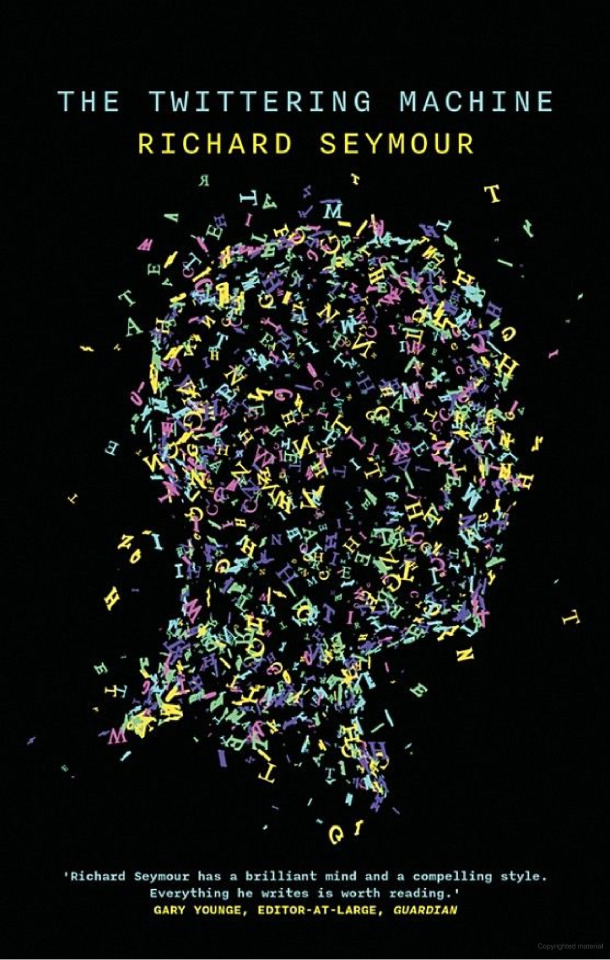
I have read the Twittering Machine by Richard Seymour, to delve more into this internet phenomenon of trolls thriving on negativity through memes, online mobs ‘fake news’ and alt-right subcultures.
There is a text I chose (Seymour, 2019) “In technology, we find our own alienated powers in a moralised form: either a benevolent genie or a tormented demon. These are paranoid fantasies, whether or not they seem malign, because in them we are at the mercy of the device” meaning that we have made these man made tools with access to this concept of “imaginary” digital space due to the internet. Alienated powers described as otherworldly qualities we have given to this recontextualised device as we stand behind these screens unscathed from any consequences whether for good or bad from affecting lives, which goes with “benevolent genie or tormented demon”.
From the same extract (Seymour, 2019) “if we found ourselves addicted to social media, in spite or because of its frequent nastiness, as I have, then there is something in us that is waiting to be addicted.” There is an issue here being exposed, how we in human nature have a natural need for attachment towards something consistent. Which has been proven and enabled by social media platforms, I would also say maybe it has to do with how each one of us has a chance for a “voice", to be heard and witnessed by having their statement being shown upfront on our screens worldwide, big capitalist corporations can take advantage, buy these “reach” for the spotlight but it can also mean any number anonymous people of all down sides of humanity can be heard of their outlandish, out right mind numbing tweets by the cold algorithm. Simultaneously give out belittled communities as supported by Seymour “Those who enjoy the social media platforms tend to like the fact that they give them a shot at being heard. It weakens the monopoly on culture and meaning formerly enjoyed by media and entertainment companies. Access isn't equal - reach is bought and paid for by corporate users, PR agencies, celebrities, and so on, who also have better-funded content - but it can still give marginalised voices a chance…”.
Furthermore, going more into the pessimistic style (Seymour, 2019) “Trolls are the anti-celebrities. They are propagandists of human failure. Far from extolling awesomeness, they ruthlessly exploit and weakness: for the lulz.2 They remind you that there's always a point of view from which you don't matter, and from which your pain Show Up is hilarious." Here it explains to us that Trolls are empathless, stoned on humiliation of anyone within its radius. They are the “fallen angels” to be dramatic, fallen from grace and now depraved and looking to sink anyone to their level. In my personal bias I believe they are straight evil unfortunate livelihood due to circumstances so they project their own misery to others in “fairness” from their perspective.
Bibliography
Seymour, R (2019) The Twittering Machine. The Indigo Press.
0 notes
Text
Midway project 4 Development
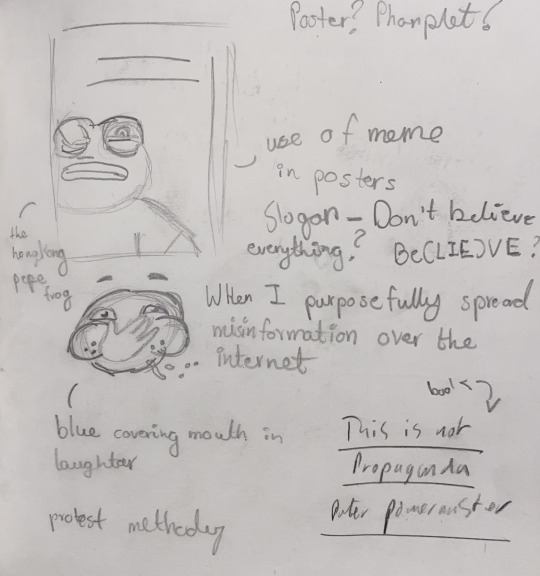
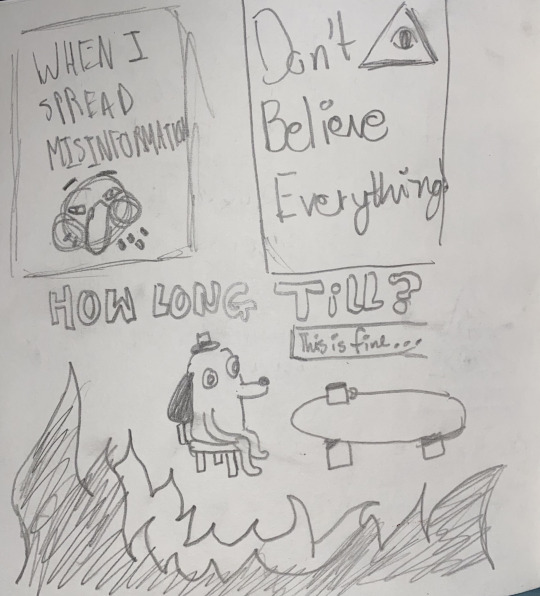
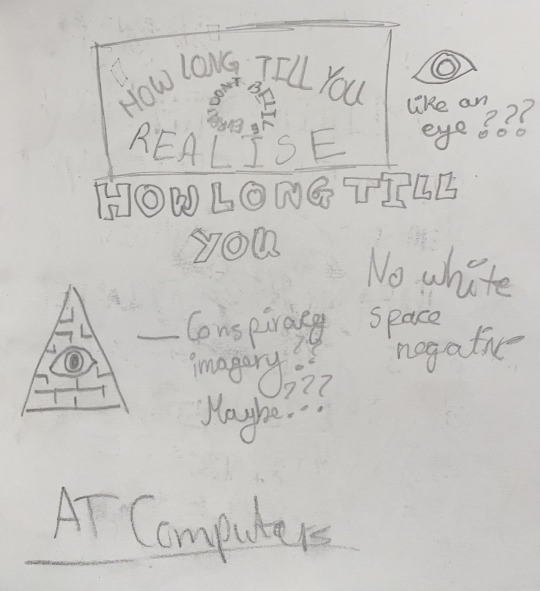
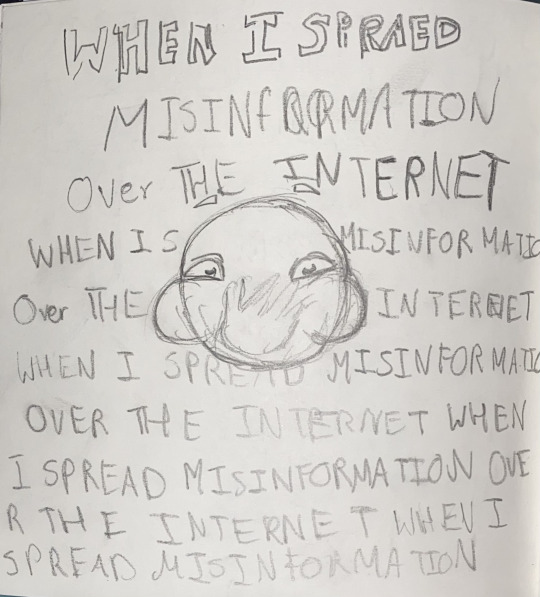

Developing my project, I decided to appropriate my designs/these digital memes, famous internet visual imagery by riso print on paper, making it through layer by layer. The reason I went with this route, producing these digital images as prints is because it will give off an “industrial” vibes on paper or those old, retro, propagandist print posters but it's conveying to be wary of information we consume. The use of traditional practice makes us feel more attached, more engaged then if it was digital as we can interact personally with this physical object. My first design here is of a recent popular top text, bottom text format meme of a blue, cartoony, exaggerated emoticon of the “holding in laughter” body language. Exaggerated laughing that is unjustified by outside circumstances is known as paradoxical laughter.
Uncontrollable laughing may be present, and the individual experiencing it may understand it as being inappropriate. Which in hand goes in with the text of “When I purposefully spread misinformation on the internet”, this is explicitly suggested the member involved here knows they are playing a trick and lying to the other party involved to create discord. More of a Trickster role, which goes hand in hand with the “troll” aspect of the internet, spreading misinformation although cause diffusion only for momentarily as its mostly used in a light hearted manner on mild silly topics for quick laughs and momentary idea of “wrecking havoc”. However does not mean it can and was not used on serious political agenda, as “Bait” to cause a reaction for likes and mentions. The goal being to be the centre of attention and thrive on negativity. I decided to the background filled with the text “When I purposefully spread misinformation on the internet” in repetition, from up to down as it slowly transfigure and morph into an unreadable language overtime to show how it can be easily be misconstrued over time from its original prier totally ignoring the message as a light hearted, innocent to rancid and incomprehensible. Also the main figure being in the centre to show its roots of the meme.
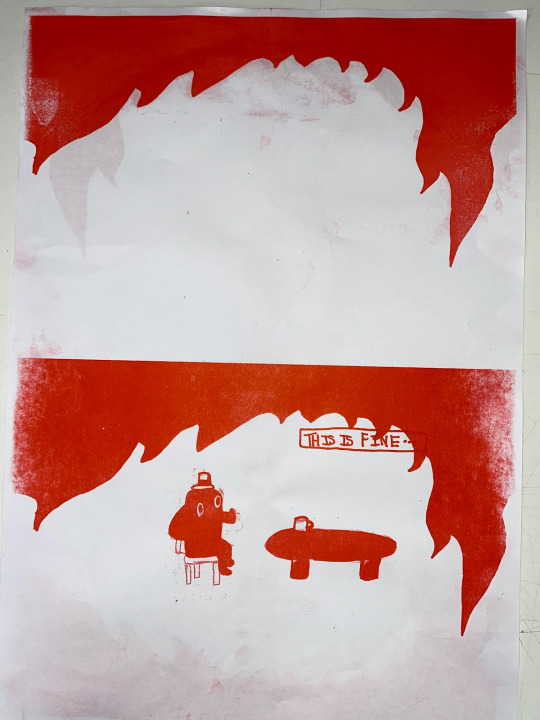
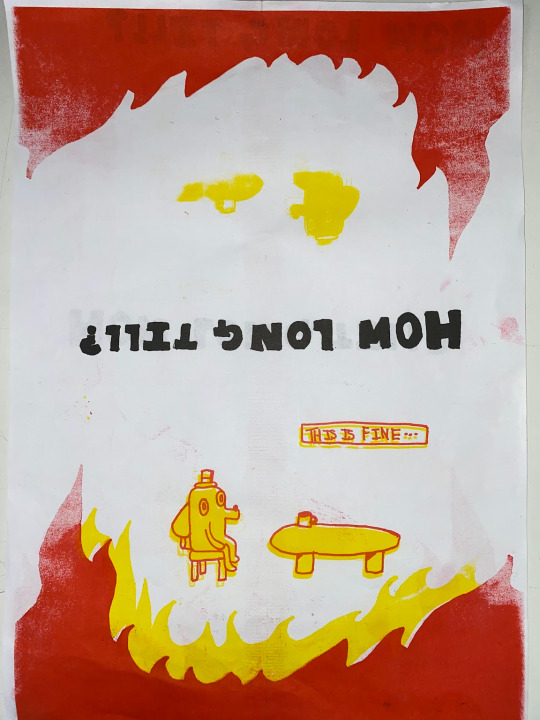
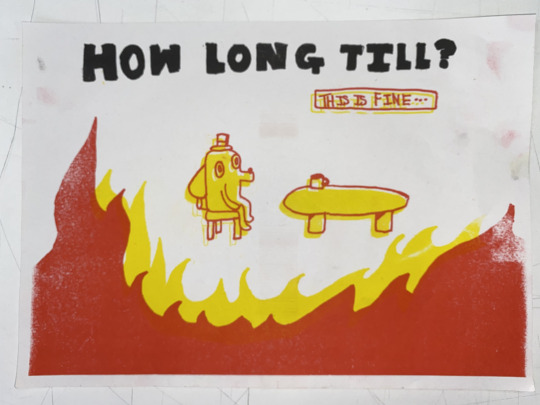
Next my second design, is an appropriation of a comic panel that has been widely used as a viral meme due copy fidelity. This is a two pane reaction image that originates from a short comic “On Fire” by an illustrator K.C. Green's Gunshow comic #648. Shown here is a two-pane image of an anthropomorphic dog trying to assure himself that everything is fine, despite sitting in a room that is engulfed in flames.
As you can see the progress I was having difficulties with the riso printer but after a few unsuccessful trial runs, it came out well I would say, though they were faint marks on the red ink I would say it adds to the “chaos” inside the frame and also adds the “industrial” texture.
0 notes
Text
KC GREEN illustrator Research
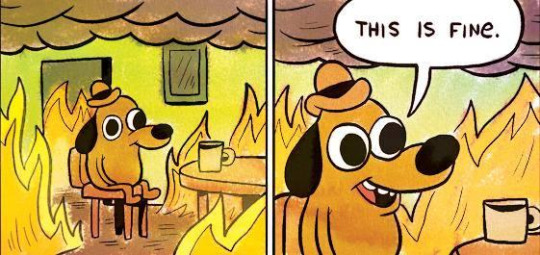
This is a two pane reaction image that originates from a short comic “On Fire” by an illustrator K.C. Green's Gunshow comic #648. Shown here is a two-pane image of an anthropomorphic dog trying to assure himself that everything is fine, despite sitting in a room that is engulfed in flames.
First time used as a 2 panel reaction image was on April 26th, 2013, the comic's first two panels were submitted to a thread on 4chan's /vr/ (retro games) board. On January 10th, 2014, Redditor theonefoster submitted the first two panels to /r/funny with the title "Accurate representation of me dealing with university stress".
I chose to go over this because this is a viral, well known meme on the internet. The imagery used here shows that an individual is aware of the turmoil going around them but is showing irony saying comforting, uplifting words contrast to the obvious chaotic background. Is used as a reaction image used by forum posters trying to say calm in stressful situations. The simplistic 2 panel can be used in most scenarios making it an appeal to the people who want to vent their frustration of how they feel, a relatability through humour.
I would say the relevancy this to my project is that the different usage of this reaction image, in July 25th 2016, the Republican National Committee tweeted the two-pane reaction image via its official Twitter account @GOP as a commentary on the chaotic atmosphere of the opening day at the Democratic National Convention in Philadelphia, accompanied by a shrug emoticon and hashtags #DemsInPhilly and #EnoughClinton for their own agenda.
Within an hour of @GOP's post, K.C. Green was using Twitter to express his personal disdain for the Republican party in response to the Republican National Committee's improper use of his artwork.

The political cartoon website The Nib then replied to the @GOP tweet early on July 26th with a customised version of the original cartoon that substituted the Republican elephant for the cartoon dog; it was created by K.C. Green himself and commissioned by the website for display at an art gallery in Philadelphia's Old City neighbourhood.
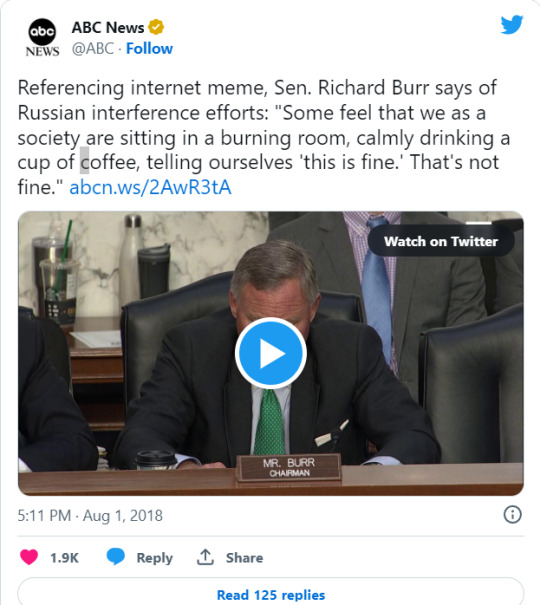
Senator Richard Burr of North Carolina made a reference to the "This Is Alright" meme while criticising Russian meddling in American politics in a video that was published on August 1st, 2018 by the ABC News Twitter account.
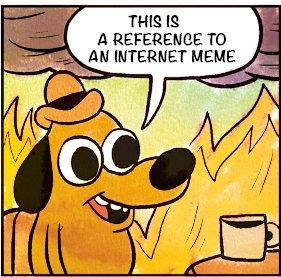
On that day, @davidmackau replied to a tweet with an edited version of the comic that read, "This is a reference to an online meme" . On that day, pieces on the reference appeared on a number of news websites, including Time, The Hill, and Inverse.
This panel has influenced people from digital space to reality, the power of memes affecting reality. So I thought maybe I could incorporate these in my campaign since the younger generation “hit the nail” of whatever message I want to convey. More having a modern, “mematic” protest poster where they get a slogan and use memes from internet culture to make straight, effective yet funny points.
2 notes
·
View notes
Text
Initial research, Pepe the Frog
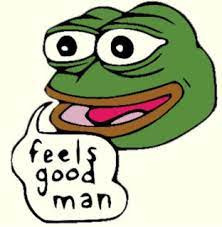
Pepe The frog is created by the artist Matt Furie
I would say its the the whole entirety of this meme Pepe the Frog I chose and not just one specific artwork, the legacy, idea behind this frog illustration. What is interesting about this artwork is that was created as a little silly guy, a "loser" person and that frogs owns that "loserness". Just hanging around its friends in small comics around the myspace day and how it is drastically different to the present, the reputation of this meme.
How is this related to my topics that I am doing? I would say that I my idea is revolving around the first project, Modernity, of the internet, digital space, memes and going further by how the net manipulates information, Misinformation, censorships? etc. and also how the meme culture revolves around it, how does it help with the spreading of information through memes, there partake in it.
2 notes
·
View notes
Text
Project 4 - Research Project
To begin this brief, I chose my first project “Modernity” from the first semester to start with because I delved into memes and internet culture before, specifically the visual communication in modern language today developed from the world wide web. Now I was thinking of diving more into the surrounding of it, such as “Misinformation”. From what I have seen most online takes or statements are from misinformation, example, “Baiter” meaning a person who intentionally makes someone angry by saying or doing things to annoy them/ provoking a reply so people can engage in their tweets for lil fame on the internet. It can also be seen from politics with fake news, with an “agenda” to the little meaningless culture wars on twitter with “alt right” and the “far left” groups on twitter. Even on memes where internet jokes come alive from just a little misinformation such as “Lea Michele” after being jokingly falsely accused of being dyslexic so people would instead of texts, but with associated emojis for the visual communication etc.
I would say what went well in the last semester was I was more well tuned with researching and statement & visual documentation relating to my ideas carefully throughout and I was hoping I could hope to develop this world of memes going hand and hand with misinformation and why these might have something to tell us about “modernity” now.
0 notes
Text
youtube
PROJECT 3 - ANIMALS, FINAL OUTCOME
THE MOON RABBIT
0 notes
Text
WHY THE ANIMALS?, RESEARCH OF RABBITS/HARE

The animal I was allocated with was “ Hare/Rabbits - Fertile, febrile, the leaping renewal of spring…” from this I could only think about that they are known as energetic creatures, fertile meaning as they have high breeding activities and association with spring and birth is linked with well the new year, also new year as in the rabbit is the fourth animal in the Chinese zodiac and symbolises grace, beauty and good luck. Rabbits are also associated with the moon, because of the mythical Jade Rabbit who lives there, animals coming out of hibernation from winter, etc.
Before this project, I would have had no idea the difference between a rabbit and a hare, at least the specific characteristics that differ between them. If you asked me then, what's the difference about both of these animals I would be in a disarray on the spot. They are both in the family of Leporidae, All genera in the family—aside from Lepus—commonly go by the name "rabbit," while Lepus individuals—almost half the species—commonly go by the name "hare." Hares are mammals as are rabbits, they are herbivores, and live solitarily or in pairs. Nest in slight depressions called forms, their young are able to fend for themselves shortly after birth. Most are fast runners with long powerful hind legs and large ears to dissipate body heat. Whereas rabbits are well known both as a domesticated form of livestock and pet and as a wild prey animal. The rabbit has a significant impact on ecologies and civilizations, and it is commonly used as food, clothing, a companion, and an inspiration for art in many parts of the world. Since a rabbit's primary defences against predators, such as the speedy fox, are speed and agility, rabbits have robust hind leg bones and well-developed musculature
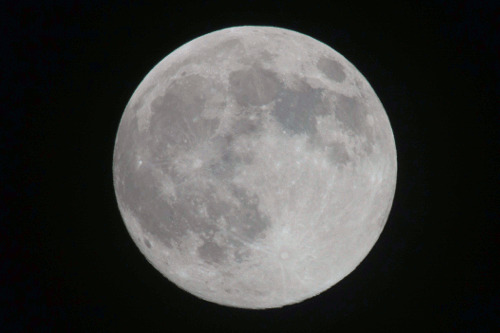
The rabbit is now so widely known through photographs and is so effective as a logo-like image, as it has been introduced to every continent but Antartica. Talking about logo-like , it is also a symbol of the playboy, of fantasy which comes to mind with “fertile… the leaping renewal of springs”. In America the rabbit is of sexual significance. It is aesthetic, bashful, and enthusiastic, and it jumps all the time. Get the picture. In most European culture, rabbit and hares are mostly associated with negative connotations of unbridled sexuality and lust, an unclean animal but also seen as health and vitality yet also chastity and purity throughout history. Paradoxical superstitions, presumed to bring fortune or misfortune due to the animal behaviour in human society, always putting their actions through human standards. Rabbits are considered hunter's quarry because their only ways of survival are to often reproduce and run away from predators. A weak, small animal guessing from that it can also be interpreted as something innocent, not an aggressor. In history, they needed something to physically represent these qualities, symbolise them. I found myself particularly interested in how old societies always have some similar ways of thinking, even though at the time they would have no worldwide view yet come to the same conclusions or take from each other unknowingly. The far east has the moon rabbit similar folklore taking from the shape of the dark patches on the moon, yet have a different story of the figure.I have looked into issues such as ‘Peak District Mountains hares becoming extinct’[2], “Our findings are deeply concerning. Whilst there are a couple of places where mountain hares are abundant, most of the Peak District hills have very few hares remaining”[2] which is kind of ironic as the hares/rabbits are associated with birth, vigour and fertility. Which also goes into rabbit virus, which has jumped to threaten the UK hare population.I have also seen magazines that discusses “that the rabbit population has diminished to such a degree that it will need human intervention to recover”[1] it has become such a train wreck it has to be dealt with human intervention, the rabbit has has made their nest a breeding ground for these killer viruses “Evidently, it is the burrows that harbour killing

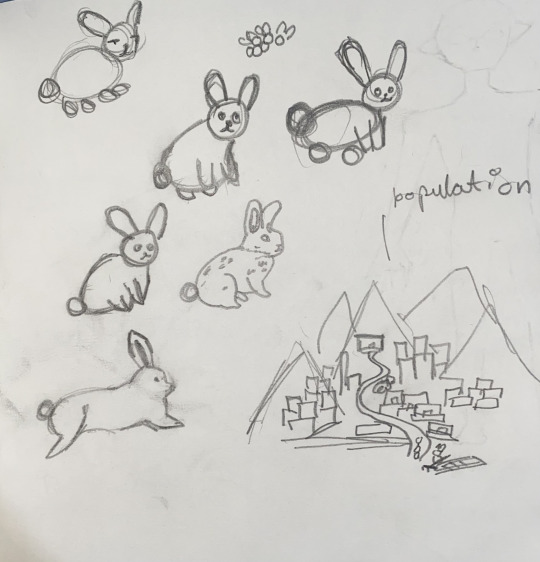
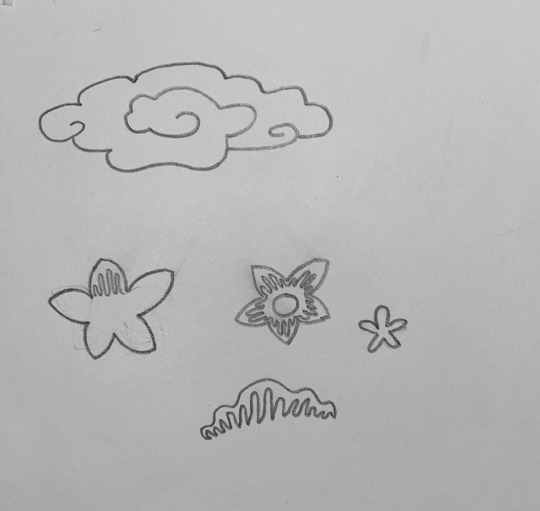
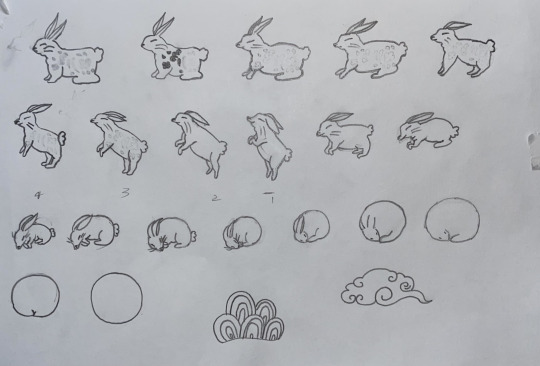
viruses and myxomatosis and haemorrhagic disease have been causing havoc among the rabbit population.”[1].
Overall, I thought for my outcome, I would make a time stop animation for my rabbits about the cultural take on rabbits to humans, especially the eastern folklore of the Jade rabbit that lives in the moon using both traditional and digital mixed medium. At first through my developing stages I was thinking about doing the news about “Peak District Mountain hares being more abundant” than they thought associated with fertile population, new life, fresh beginning similar to my definition of my animal given. However midway found out it was misinformation, the exact opposite abundance. So instead of tackling an issue I thought of recreating the cultural lens of rabbits in animation, The Moon Rabbit. There were some few problems throughout as it's been a while doing animation on adobe after effects and then timing the frames but I overcame it. I really do like the outcome of mixed media pencil figures and digital painting backgrounds.
BIBLIOGRAPHY
Rabbit, rabbit, rabbit. 2022. Country Life, , pp. 53. [1] magazine
Turnbull, D. (no date) Peak District mountain hares at risk of extinction, The BMC. Available at: https://www.thebmc.co.uk/study-finds-peak-district-mountain-hare-population-unsustainable (Accessed: January 23, 2023). [2]
0 notes
Text
Animal Project 3, Reading Report
For my book report, I have read extracts from ‘All Animals are Equal’, Animal Liberation, second edition, (London: Pimlico, 1995), pp. 1–9 by Peter Singer. In this extract, the points made here were the rights for animals, non human, which at first was actually a parody refute to the notion of women rights by Thomas Taylor. Mary Wollstonecraft published her ‘Vindication of the rights of Woman’ (Singer, P. (1995) All Animals are Equal . London.[p.1]), many found the view absurd and to take it up a notch Thomas published an satirical work to apply the same reasoning to “Beast” dogs, horses, animals in general, applying the identical reasons therefore making the view of women’s rights unsound. Then it devolves into the complexity about the concept, equality of humans and how it might differ due to individualistic characteristics, race and sex, comparing it to the animals.
There was a standpoint of how it recognised the equality between human and an actual animal in its literal sense, how dogs don't have rights to vote because they can’t write or hold a pen but humans can vote, etc. concluding how they should not “require equal or identical treatment; it requires equal consideration. Equal consideration for different beings may lead to different treatment and different rights.”[p.2].
However, There is also an argument of this by the writer “The existence of individual variations that cut across the lines of race or sex, however, provides us with no defence at all against a more sophisticated opponent of equality, one who proposes that, say, the interests of all those with IQ scores below 100 be given less consideration than the interests of those with ratings over 100. Perhaps those scoring below the mark would, in this society, be made the slaves of those scoring higher. Would a hier- archical society of this sort really be so much better than one based on race or sex? I think not…” well not really an argument but an opposition to this, an example of what that would have been mentioned at least once in this life.
I found the way the writer talked about the animals rights and how it correlated with the discussion of human rights, specifically women rights. I found this very successful as I liked the realisation of the different requirements of animals and humans, of racism and sexism, equity is needed.
0 notes
Text
PROJECT DOCUMENTATION OF OUTCOME IDENTITY
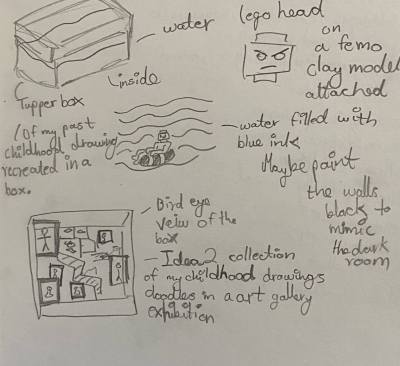
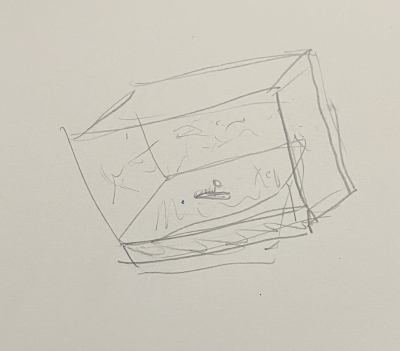
For this project, it was about identity, meaning to express yourself through characteristics, appearances, experience. During these lectures/seminars we have talked about the nature of identity, There are many subcultures in youth dealing with identity. Language, culture and history, your experience against the world. There is Nature vs nurture from a standpoint, exploring around the foundation of identity of how people become who they are. Identities are superficial, the structure of identities is born through symbolic networks, systems of representation and social classification of societies in which we live that scientists have argued

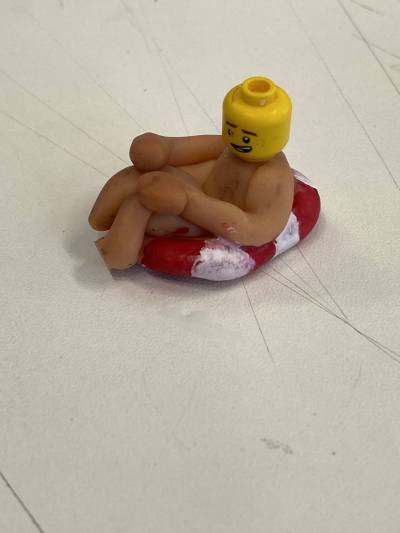
I will be focusing on the identity around childhood and the internet universe. In this new day and age technology has intertwined in our day to day lives, giving us our own virtual space through the internet such as Virtual Reality, this alternate augmented reality where we can be anything/anyone through a virtual avatar. During everyones Childhood you are a different person to how you are now as an young adult, that's a period of time where you are starting to discover who you are or get a better understanding your surroundings. So for my project I decided to recreate one of my childhood painting of this character I used to relate with now revisited as more grown person for my outcome.
Its of how I look at an aspect of my identity through differently as I have grown, how I look at the same thing but through different lenses from an childish drawing to creating this alternate reality where this space exists which also takes concept of an avatar in an virtual reality, this is their home its where they live in and associate with.

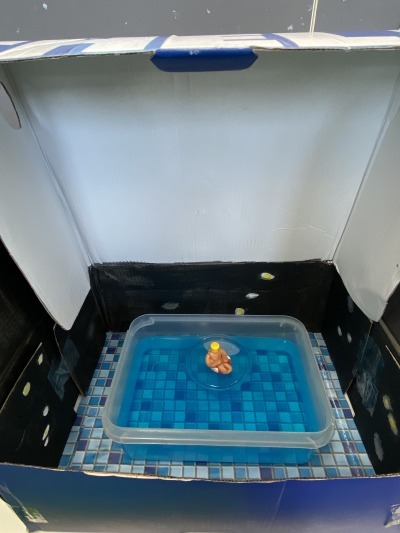
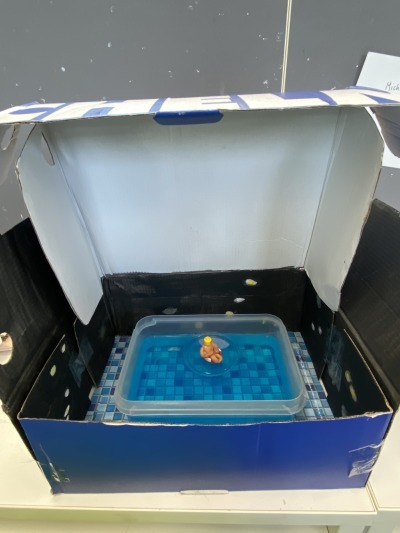

0 notes
Text
Project 2- Identity Exhibition Report
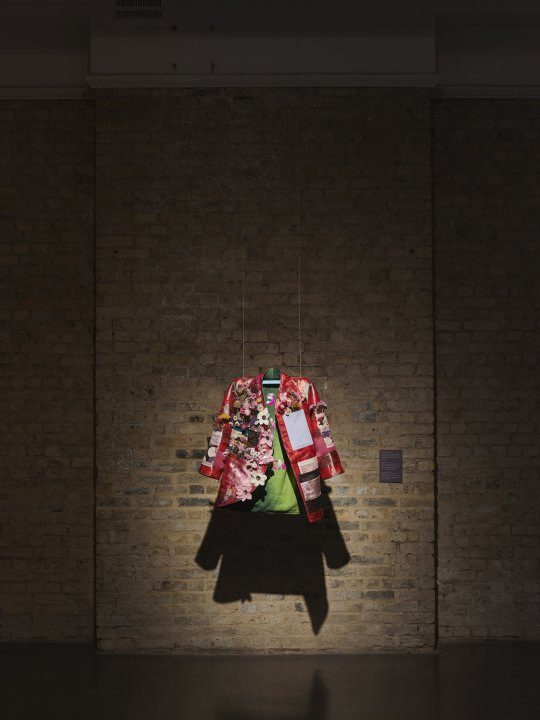
On Tuesday 22 November for my identity project I went to see an exhibition, Zadie Xa: House Gods, Animal Guides and Five Ways 2 Forgiveness at the White Chapel Gallery. It's an art installation, Zadie Xa presents her issue of familial legacies, histories of migration and the ways in which different species communicate with one another in sculptures, textiles and paintings, coming from the artist’s spiritual, folklore, religious rituals with hybrid and diasporic identities on a large scale structure inspired from traditional Korean home, hanok, filled with enveloping audio and lighting transforming a historic architect into this mystical landscape.
In this exhibition what I found interesting is the way she uses the framework of Korean mythology as a narrative to explore these issues. Paintings, sculptures, textile works, hanging puppets, and masks are featured throughout the exhibit, many of which depict various types of animals. Animals are often the main characters in many fables, which help educate society and help talk about power structures and moral dilemmas. The recurring concept of tigers, foxes and seagulls speak to Xa's continued exploration of the "trickster" archetype. Its existence is a disruptive outsider that causes and inspires change in the general social and cultural order. While Xa narrates that have been erased and repressed by the West, where her diasporic identity comes to play here. This is also reflected in the title of the exhibition, 'House Gods'. This refers to the spiritual practices of Buddhism and Korean shamanism, as well as communities around the world who practise ancestor worship and pay homage to the "house deities." Widely worshipped by many different cultural groups about gods and spirits that protect the home and ensure prosperity and health. It also refers to the belief that by acknowledging the deceased and honouring family ancestors, a god or spirit will forgive past wrongdoings and bring happiness to the home. This forgiveness in the artist’s own journey comes in play with how the diaspora are disjointed from their cultural communities and the ways in which regrouping can be sought through acknowledging those that came before us.
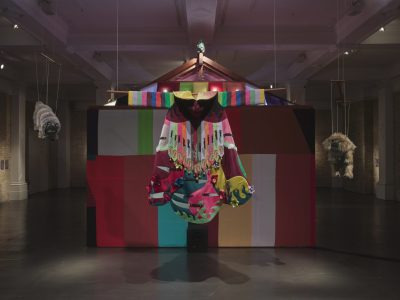

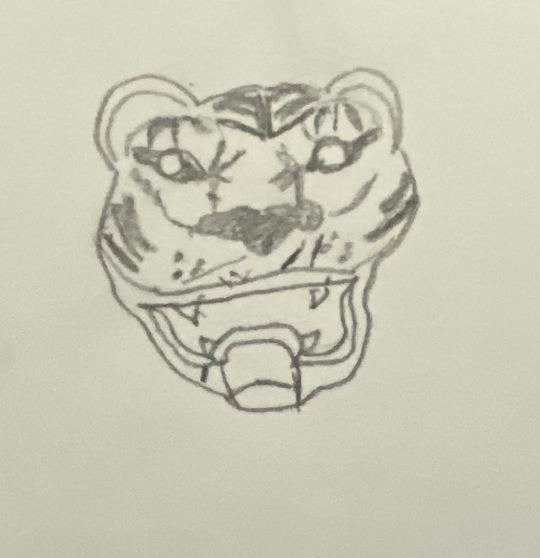
0 notes
Text
Identity Book Report (Project 2)
This book report assignment I have chosen to read Meg-John Barker (auth.) and Jules Scheele (illust.), Queer: A Graphic History (London: Icon Books, 2016), pp. 3–31. Reading this extract, I have found its about the queer identity, the culture of “Queer” and explaining the sorrounding of Queerness, its history. It talks about the origin of “Queer” and the multiple usage of the word through time,” how wider western culture came to understand sex and sexuality and how Queer theory challenges this”, activists and scholars laying the foundation of Queer Theory and what direction the current Queer Theory has led in recent years.
The key ideas in this extract are the challenges the binary concept of sex and gender “the Queer Theory goes further then this in questioning the whole concepts of sexual and gender identity”.
The standpoint of this extract was trying to understand cultural norm and expanding on that, outside of the box, sexual identity & critism of queer theory. I found particularly interesting the way the book is shown as a informational picture book because to the new readers it could be bothersome/drag, no one wants to read heavily text theory as “Queer Theory has been criticised for being inaccessible and full of difficult word” with the addition of pictures with information helps the viewer understand and more easy to visualise the difficult concepts. It has raised some issues with some gay movements as its goes forward yet goes backward at the same time. It has made these arguments more heard due to the less threatening approach to the mainstream society but these cause problems “assimilationist strategies it employed” it's like a double edged sword. Still having a fixed aspect of identity, retains the status quo rather than pointing out the flaws of how mainstreams sees sexuality, “it's not our fault” easily slips inti making homosexuality inferior, those who do no quite fit in are easily dismissed. I would best support this argument as I have seen this happen to many times on Twitter with these type of discourse, as many people debates are too surface level and don't look into deeper level unintentionally/intentionally twist narratives.
0 notes
Text
Documentation Graphic Media Modernity
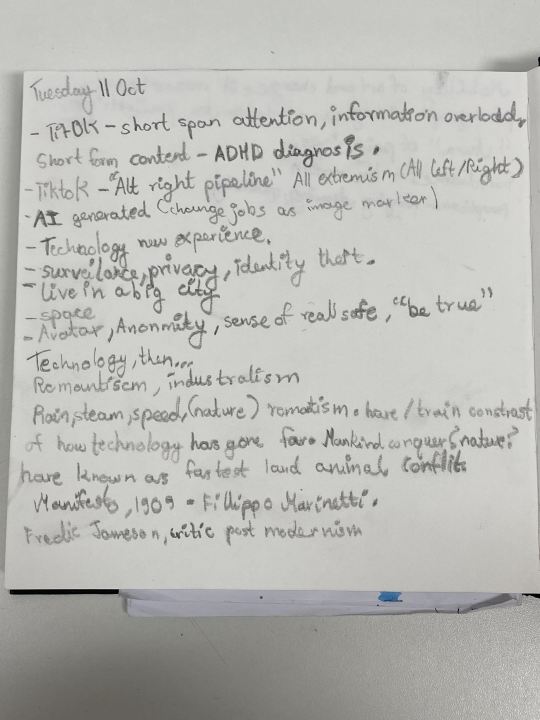
The Project of Modernity, for my final piece I have made selections of screen prints as my response to the topic. In this module we discussed everything to do with the “modern” world and the differences to the “past” world such as politics, religion, economy, society, culture and technology compared to the present. If anything has stayed the same or has changed through the years in them. We have found history about the class system in Great Britain, Bourgeois VS Proletarians, the political propaganda, internet silencing but what made me more interested was the technological advancement, primarily the Internet, this digital space a whole new dimension across the globe “World Wide Web”. An aspect like we engaged how people are acommodified, using them as data like dating apps for finding potential love partners. Involvement of technology came with such as TikTok making people have short attention span due to quick paced short form content, the effects of social media.


All these side effects with technology and how it changed the way we speak to each other through social media Twitter, YouTube, Tumblr, etc. The digital language and how it developed and changed the ways we can interact with others. I am exploring the idea of the internet, specifically memes, the visual communications in modern language today developed from the web like twitter, YouTube, 4chan, Tumblr, etc.
As going on from the discussion I made a small note in the corner words related to the Internet to generate quick ideas which then lead to me sketching what I would possibly do for my project, having iconic memes that are very illustrative like Pepe The Frog, Troll face, Phones, the internet slang as “slay” and “Yass”, Twitter sticker because of the font and profile icons. Next, the sticker led me to an idea of having a typography and the words used are all internet slang in the corner as it slowly spreads outward to a space of drawings of silly funny cat pictures. However, I decided to scrap the Idea of cat memes and have much more visually known illustrative designs like Pepe the frog.
Next, I planned out my two black and white layers for screen print first done with a sharpie halfway through using ink as it was better. You can see I have made changes from the first draft.



Finally the time for printing, I prepared my screens with my designs on them and headed on. I did some experiments with ink on newsprint with green and red to test the process. After I was satisfied I began doing my “Final” pieces, one with all of the typography and illustrations and one without the pink “Nyan Cat”. Unfortunately there were some errors through the process due to the wet screen but some of it turned out quite nice even though it was not intended. Overall, I am satisfied with my screen prints having variation with the two layers.









0 notes
Text
Artist Research- Mark Callahan- Modernity

“Mark Callahan is the Artistic Director of Ideas for Creative Exploration (ICE), an interdisciplinary initiative for advanced research in the arts at the University of Georgia, Associate Academic Director for Innovation in the Arts at the Willson Center for Humanities and Arts, and serves on the faculty of the Lamar Dodd School of Art. He is a graduate of Cranbrook Academy of Art and the Rhode Island School of Design, where he was a member of the European Honors Program in Rome, Italy”. Callahan has experience in traditional printmaking backgrounds then moved into experimental multimedia projects
This particular artwork of his, ‘24 Hour Miss South Carolina’ made for the exhibition “Memery: Imitation, Memory, and Internet Culture” is an artistic exploration about “how memes transcend the virtual world, manifesting in public consciousness and current news stories”. The artists were given instruction to produce “that questions the impact of memes and memory in our visual culture” which helped produce the artist's response. In this exhibition artists source the internet such as Youtube, websites, Social Networking, Flickr, video blogs, etc. to produce their work. Which is the origin of Callahan’s ‘24 Hour Miss South Carolina’ , a piece appropriated directly from Youtube. Context, the material is of a viral youtube video in 2007, a teenage beauty pageant contestant, former Miss South Carolina Teen USA Lauren Caitlin Upton, made a thirty-second speech to a question why twenty percent of Americans cannot locate their country on a map? that became a media phenomenon, fueled by millions of views on the Internet and a brief but intense outpouring of parodies. It’s also an homage to “Douglas Gordon’s seminal 1993 installation, 24 Hour Psycho”, the video being “Slowed, stretched, and silenced, the work repositions an object of short-lived attention and mass ridicule to an epic progression of still images”. Callahan’s silent, slow motion appropriated video extends the pain from Upton's answer as we already anticipate what she would say. I feel like this work is talking about the “nature of celebrity, voyeurism, and entertainment” in this technological modern experience. How famous yet unknown(true self) person’s unflattering moments have been recorded into video for everyone to see it as a joke of how unbelievable it is and now again have this moment glorified for everyone to see in a public space. This relates back to how in our lectures the idea of memes (inside internet joke), digital space, relations to people and the huge fast information spread has made a cultural impact on modern society and also art mediums evolving with the use of the net.
Mark Callahan’s artwork has relevance to my own graphic media project as I am exploring the idea of the internet, specifically memes, the visual communications in modern language today developed from the web like Twitter, Youtube, 4chan, Tumblr, etc.
REFERENCE
“Memery: Imitation, Memory, and Internet Culture” “how memes transcend the virtual world, manifesting in public consciousness and current news stories” "that questions the impact of memes and memory in our visual culture”
Copeland, C., 2011. Mutating Memes. Afterimage, [online] 39(3), pp.22-23. Available at: https://web-s-ebscohost-com.ezproxy.mdx.ac.uk/ehost/detail/detail?vid=0&sid=4f2394da-c176-4192-ac7d-04f2bcb85b75%40redis&bdata=JkF1dGhUeXBlPWlwLHNzbyZzaXRlPWVob3N0LWxpdmUmc2NvcGU9c2l0ZQ%3d%3d#AN=70239701&db=hlh [Accessed 16 October 2022].
“Mark Callahan is the Artistic Director of Ideas for Creative Exploration (ICE), an interdisciplinary initiative for advanced research in the arts at the University of Georgia, Associate Academic Director for Innovation in the Arts at the Willson Center for Humanities and Arts, and serves on the faculty of the Lamar Dodd School of Art. He is a graduate of Cranbrook Academy of Art and the Rhode Island School of Design, where he was a member of the European Honors Program in Rome, Italy”
“Douglas Gordon’s seminal 1993 installation, 24 Hour Psycho”
“Slowed, stretched, and silenced, the work repositions an object of short-lived attention and mass ridicule to an epic progression of still images”
“nature of celebrity, voyeurism, and entertainment”
Terminalapsu.org. 2022. » Mark Callahan Terminal. [online] Available at: <http://www.terminalapsu.org/tag/mark-callahan/> [Accessed 16 October 2022].
1 note
·
View note
Text
"Always On" Sherry Turkle Book report 2 Modernity(city)
I have read the essay “Always On” by Sherry Turkle and it's about how Pia Lindman explores how people, her colleagues and daughter relate to each other due to the ways of social media and digital technologies in our lives. Sherry Turkle explains through herself in the perspective of Pia Lindman, she observes the “cyborg life”. She noticed how the mixture of digital and reality have changed people’s lives for the better and worse and ultimately hers, we hear about the psychological behaviour surrounding human interaction in the city, where once communal spaces (cafes, parks, airport and train station etc.) have become “...a place of social connection: people come together but do not speak to each other” meaning these days our connected dependency is not from the distance of each other but the available communication devices. I would say for myself it has become part of my routine to always have my technology with me everywhere I go, I feel secure, safe and reassured. I could talk to my friends via a finger tap, update on social news and have all my needs in apps on my smartphone. I would also agree with her on somewhat on how looking down on your phone is as being closed off, “absent” from the outside world where we want to get interrupted from reality, like as mean getting on your phone we isolate yourself from our surrounding to communicate in digital instead off chatting with some random person next to you but at the same time who would talk to a stranger when you could converse with your friends digitally? The internet becomes a second life, a city in its own way with public tweets relating to hearing a conversation while walking through the busy streets, private twitter as enclosed space/home only family/friends can interact with and the online ads(advertisement) as billboards and posters on the urban walls.
In what relevance this has to me, for this project the existence of this digital space fascinates me and the development of language in those spaces changed how we interact with each other. New phrases and visual communication are rising with such as memes, reactionary images(gifs). From there it creates a new subculture of groups, how we speak can also be a signal to let others know as we are one of them, like relations to certain parts of a city.
0 notes
Text
Modernity Book Report 1
I have studied excerpts of Chapter 1 “Bourgeois and Proletarians” from The Manifesto of the Communist Party by Karl Marx and Friedrich Engels (1848). This excerpt explains “the history of class struggles” and how the foundation of our society and the generations of societies before us were built based on that idea, a class oppressing the other class. Specifically, between the Bourgeois, the capitalist class who own most of society's wealth and means of production, and the Proletarian, the working class. It also describes the demolition of the orders of the middle ages from the development in the modern world, how it has “simplified the class antagonism” making into a more black and white, two great classes on each other. The paradoxical nature of capitalism, renewal and destruction because of its own fast over production.
Reading this excerpt, I see it as a critique and overall view of the development of the class system in the modern world. Karl Marx is implicitly arguing against the bourgeois but also looking into the nature of both of the classes, calling out on their flaws “as the whole historical movement is concentrated in the hands of the bourgeoisie; every victory so obtained is a victory for the bourgeoisie” commenting on how the proletarians becomes “incoherent masses” fighting their enemies' enemies, yet it’s not their fault but of the bourgeois unions. However, the “What the bourgeoisie therefore produces, above all, are its own grave-diggers. Its fall and the victory of the proletariat are equally inevitable” talks about their fast production, in an restless cycle of competing self destructs itself but also praises their evolution from the old system of feudal society to a new established class.
However, I am not one hundred percent sure if I fully understood what some texts were meaning and hoping the information I read was what it meant, I am not strong in this subject. I do somewhat have relevance from this excerpt to the project I am working for this module as some idea of this extract is development, simplifying and the industrial revolution with their machinery. I am working around the idea of memes, this otherworldly space called the internet and how people communicate to each other through these visual reactionary images.
BIBLIOGRAPHY
"the history of class struggles"
"simplified the class antagonism"
"as the whole historical movement is concentrated in the hands of the bourgeoisie; every victory so obtained is a victory for the bourgeoisie"
"incoherent masses"
"What the bourgeoisie therefore produces, above all, are its own grave-diggers. Its fall and the victory of the proletariat are equally inevitable"
Marxists.org. 2022. Communist Manifesto (Chapter 1). [online] Available at: <https://www.marxists.org/archive/marx/works/1848/communist-manifesto/ch01.htm#007> [Accessed 1 October 2022].
1 note
·
View note